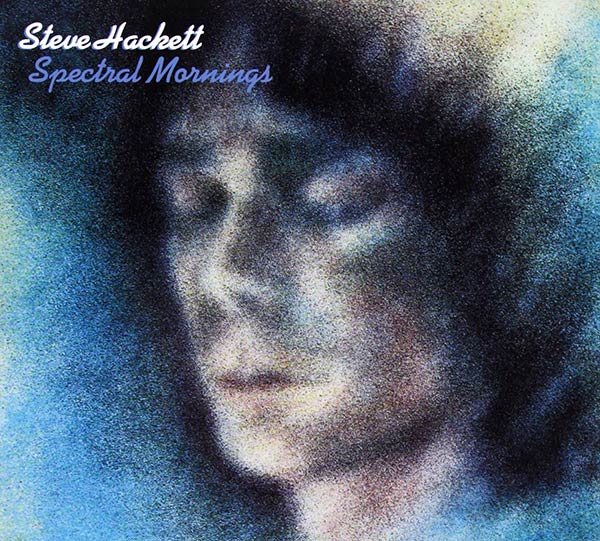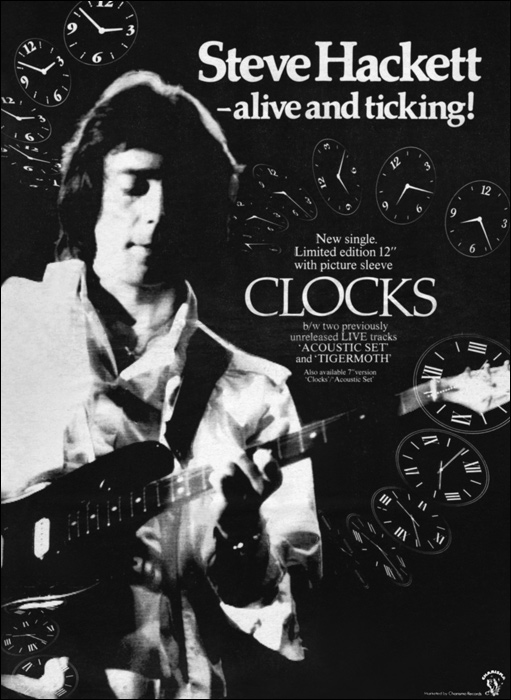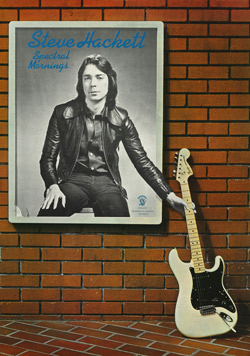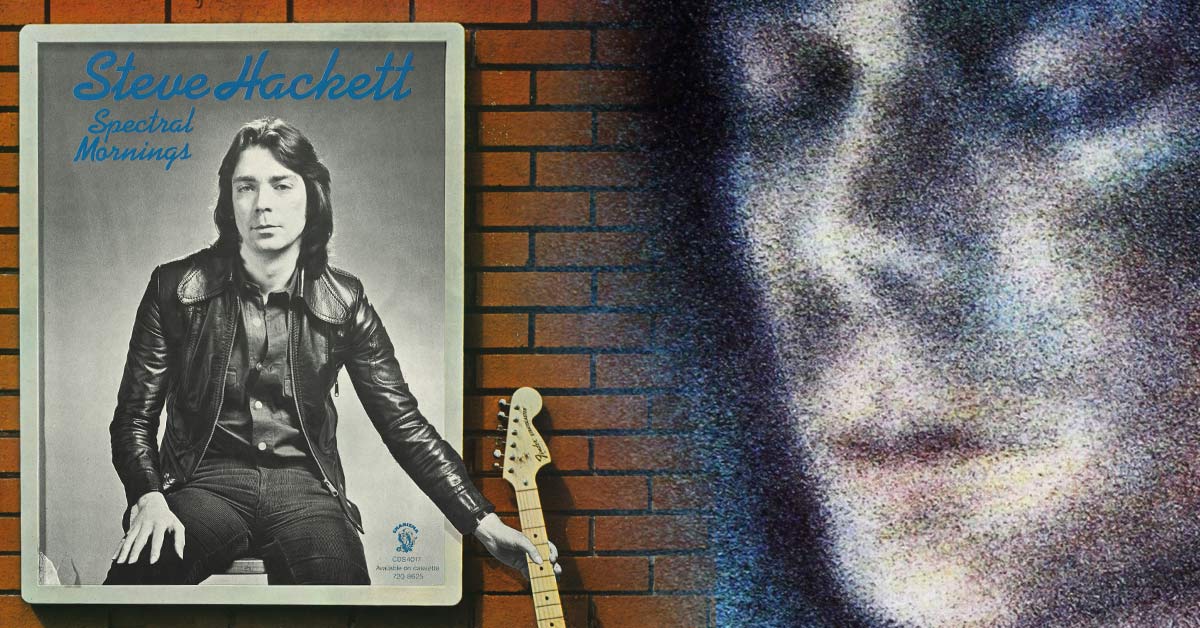- Article
- Read in 17 minutes
Steve Hackett – Spectral Mornings – album review
In May 2019, Spectral Mornings, the third solo album by Steve Hackett, celebrates its 40th anniversary. Eric Engler takes a closer look from today’s perspective.
In 1979 Steve Hackett released his third solo record, Spectral Mornings. Many fans count it as one of the best and most relevant of all his albums. When asked about his personal favourites in interviews, the maestro himself always mentions this album. In 2019, Steve brings Spectral Mornings back to the stage to celebrate the 40th anniversary of the album release. Time to re-examine the record.
At the end of the 1970s, Steve Hackett faced a luxury problem: His first two solo albums, Voyage Of The Acolyte and Please Don’t Touch sold surprisingly well, and there was much interest to see him play the music live. The former Genesis guitarist did not have a live band to do so, though: Quite a number of musicians had worked on his first two albums, including members of his former band and a number of well-known singers, and they were not available for the length of a tour. This meant he had to put together a band with which he could play his material live, go on tour and also record his new album.
The line-up
Steve decided not to use big names on the new album and went for a compact line-up. He went into the studio with the same people who had played on his first short tour – and no additional musicians. Steve wanted to record an album that had a live-feeling, too. Apart from his brother John, who also worked on Voyage Of The Acolyte and Please Don’t Touch, this was a whole new band:
Steve Hackett: guitars, Roland guitar synthesizer, Cantonese koto, mouth organ, vocals
John Hackett: flutes, concert flutes, Chinese bamboo flutes, bass pedals
Pete Hicks: lead vocals and backing vocals
Hicks had played in many rock and progressive rock band at school. As a solo artist he made acoustic music, folk and jazz. At the time Hackett approached him he was taking a break from the muso’s life and worked a 9 to 5 job. He would commute to London after hours for the tour rehearsals, reverting to full-time musician only when the tour started.
Dick Cadbury: bass, bass pedals, violin, vocals
A multi-instrumentalist with a training in classical violin and singing, Cadbury was a member of the British folk and prog rock band Decameron in which he sang, played bass and violin and later also took over guitar duties.
Nick Magnus: keyboards, Vox string thing, Novotron, harpsichord, clavinet, RMI, Fender Rhodes, Mini Moog, Rolang string synth & SH 2000
Magnus began his career as a professional musician in the progressive rock outfit The Enid, with whom he played only for a short while. For two years he became a member of progressive rock band Autumn before he joined Steve Hackett.
John Shearer: drums, percussion
He used to drum in Quiver before he joined the Steve Hackett Band, and he would go on to drum for Peter Green and David Byron. One of the students at the drum school he also ran was Craig Blundell who now, forty years on, takes over Shearer’s seat at the drums.
This was the line-up of the first Steve Hackett Band. With them, Steve went on his first tour, recorded the albums Spectral Mornings and Defector and toured extensively with that material. Hackett would work again with keyboarder Nick Magnus and bass player Dik Cadbury in later years and decades.
Recording
The recordings took place over the course of a month in deep winter with ice and snow at Phonogram studios in Hilversum, The Netherlands. Like its predecessors, Spectral Morningswas produced jointly by John Acock and Steve Hackett. Steve and his band describe this as a very intense period with little sleep, long recording sessions and lots of partying. Whereas with the first two albums the musicians simply did what Steve told them to do, now they were involved in the development and the arrangement of the songs and could bring their own ideas. The songwriting credits only name Steve Hackett, though.

Artwork
The cover used another painting by Steve’s then wife Kim Poor. It shows a portrait of Steve with closed eyes with her typical translucent and contureless style. The rear shows a photo of Steve at the microphone with his guitar (shot at a live performance); track list, credits and lyrics are printed over it. The CD version, the 2005 remaster and the new release with Steve Wilson’s remixes contain additional liner notes and photos.
Track by track
1. Every Day [6:15]
The opening track is a smasher. From the first bar you feel that this electric up-tempo piece must have developed largely in the rehearsal room. It consists of two parts: The first part is an anti-drugs song that deals with Steve’s relationship with a girlfriend who was addicted to narcotics. The music here is full of energy; it begins with a strong riff on keyboard and guitars, underlined with crisp drums and powerful bass. Though the destructive forces of an addiction (“Cleopatra’s needle”) is described in slightly calmer verses to give the united voices of Steve, Pete and Nick some room, you start wondering in the euphoric chorus whether lyrics and music really match in this song. The chords and the performance are too merry for this topic. The band play a very catchy rock song that just begs to start the party live – and we are nowhere near the climax of the first tracks that follows in the instrumental second part. There is no real transition between parts 1 and 2, unless you count the riff at the beginning and the end of the song part (with Steve playing impressively fast arpeggios) as a kind of bridge. The change is rather abrupt, though. Dick Cadbury plays a memorable bass groove that would have make Mike Rutherford proud, Nick Magnus spreads out his mellotron choirs across that foundation and John Shearer shines on drums. The undisputed star of this instrumental is definitely Steve’s guitar. Though he plays ‘only’ variations of the same motive, he still gives us the kind of elegiac guitar anthem his fans have been waiting for since the guitar solo for Firth Of Fifth. This is no hastily played solo. Steve makes his Gibson Les Paul sing gloriously and makes the best use of the long notes until a fade-out brings the coda to an end.
Every Day is the Steve Hackett classic. There is no other solo song he has played more often than this one. Every Day has also been released as a severely cut version that contains only the song part and was backed with Lost Time In Cordoba.
2. The Virgin and the Gypsy [4:29]
The second song is much calmer. Steve was inspired by the title of D.H. Lawrence’s novella – apparently Steve only read it after he wrote the song; the lyrics consist of the names of various flowers with lyrical links by Steve. It is a folky, mostly acoustic ballad with a very clear 12-string guitar and lots of vocals for several voices. Peter Hicks can be heard solo; the carefully arranged harmonic vocals by Hackett and Cadbury can be heard taking the lines of the verses alternating with the main voice. Though the verses have neither bass nor synth sounds they already have a very lush sound. An instrumental part begins after the second chorus. John Hackett takes the opportunity to shine – he actually plays a duet with himself on two flutes; they circle around each other like butterflies on a dense meadow of 12-string guitars (on twelve tracks) and keyboards made even richer by the occasional use of a guitar synthesizer. The chorus is repeated once more before the flutes take the lead again and sweeten the fade-out. The whole track has no drums at all. Only a quiet shaker can be heard and underlines the dreamily romantic mood of the track. The flutes, the bell-like guitars and the prominent vocals in three voices (arranged by Dik Cadbury) make this song sound very sweet. But even those listeners who feel that this is exceedingly schmaltzy will have to admit that this song has been crafted very well and arranged very carefully, with an eye for details.
3. The Red Flower of Tachai Blooms Everywhere [2:05]
This track, an instrumental, is probably one of the most peculiar recordings from the whole Genesis camp. What sounds like a traditional folk tune from the Far East has actually been recorded by a Brit whom you would believe to record any style from pop to classic except for something as outlandish as this. Steve plays a real Cantonese koto he had bought and practised on some time before. Carefully chosen keyboard sounds and a gong complete the illusion. Long before another ex-member of Genesis drew attention to himself by using world music it was, in fact, Steve Hackett who first picked up on music from non-Western cultures and used it in his own music.
4. Clocks – The Angel of Mons [4:17]

The ticking of a clock as a musical device has not been new since Pink Floyd’s Time. Rarely has it been used as such a dominant rhythmic element as in Clocks (The Angel Of Mons). In this instrumental, drums and sometimes the guitar, too, pick up the tick-tock beat. Incidentally, the original tick-tock sound has at least partly been created on a guitar. The track resembles the title track of Hackett’s previous album, Please Don’t Touch. Steve spreads out a gloomy theme that would work well as the score for a horror film. John Hackett plays threateningly booming bass pedals, then there is a moment of tension when only the ticking can be heard. Then the time bomb finally explodes. Steve’s electric guitar sings (or screams) out her nightmares, John Shearer hits all his drums (and has a big drum solo towards the end of the track). Steve calls this solo “elephants”, and it is, indeed, a demonstration of force that sounds like a stampede of elephants threatening to trample you down. Shearer plays the solo without any overdubs, which is always impressive for audiences as well as band mates in a live situation. Clocks is one of the big live classics in Hackett’s repertoire. The addition The Angel Of Mons in the title refers to a legend from WWI, where members of the British Expeditionary Force were saved allegedly by supernatural forces (or angels) in the battle of Mons in August 1914. Clocks was also released as a single in an edited version, with a Live Acoustic medley (Etude In A Minor, the intro to Blood On The Rooftops, Horizons and Kim) as the flipside. A 12″ single version also had a live version of Tigermoth.
“It’s one o’clock…”? No. If you listen carefully you realize it’s four o’clock, though only Steve Hackett could say whether it’s 4 a.m. and 4 p.m.
5. The Ballad of the Decomposing Man (featuring ‚The Office Party’) [3:49]
We return from instrumental adventures into the Far East and the nightmares of war to a song, a song Steve Hackett sings himself. Steve also sang one song each on his previous albums, The Hermitand Carry On Up The Vicarage. Now Steve is not one of the best singers, and he likes to hide this with lots of echo or distorting effects; both facts are well-known. In The Ballad Of The Decomposing Man we get to hear his voice clearly and untampered with. This song keeps up the tradition of Harold The Barrel, Willow Farm and Carry On Up The Vicarage; it should be understood as a musical joke or a tongue-in-cheek Silly Symphony. The focus is not on beautiful vocals. The song has frequently been understood as a political protest song about how the working people are exploited, which means the song has probably been taken too seriously. Steve said it was meant to parody the British actor and comedian George Formby and had no deeper meaning. The song begins as a western song with mouth organ (the first time Steve used the instrument for one of his songs), washboard and honky-tonk clavinet. If that was not strange enough, the song goes through a brief sequence that resembles The Voice Of Necam before it turns into a calypso song complete with steel drum and Hawaiian sounds (probably courtesy of Nick Magnus’s keyboards). Dik Cadbury adds some violin. It all seems very absurd, though it has its charme. Recording this must have been a lot of fun for everybody – The Office Party probably turned seamlessly into the studio party.
6. Lost Time in Cordoba [4:04]
On we go with the next instrumental. Lost Time In Cordoba is the typical acoustic gem with nylon guitar and flute that simply had to be on every early Hackett record. As with Kim on Please Don’t Touch this sounds quite similar to what French composer Erik Satie used to write, particularly in the first romantic part with the flute. The track becomes more playful, and Steve varies a number of dreamlike fantasies while the synthesizer plays a very calm solo with sustained notes on it. While this piece fits very well to the general repertoire of the Acoustic Trio it has never been played live (apart from excerpts in some acoustic medleys).
7. Tigermoth [7:35]
This track is divided into a song part and an instrumental part. Unlike Every Day,Tigermoth begins as an instrumental. Well almost, as it is counted in “one – two – three – four”, but the voice has been distorted to much that you guess rather than recognize the words. After very fast guitar parts Nick Magnus spreads a keyboard blanket on which the guitar spreads out playing the staccato main part that represents gun fire. The smashing drums imitate the guitar riff and lend a martial march-like flavor to the track. During the calmer parts Steve uses his guitar to create Fathometer sounds. The use of bass pedals and the brute, threatening electric guitar make this sound much like Clocks – and we have a World War theme, too, probably WWII because ‘Tiger Moth’, a Royal Air Force plane, was only built in the 1930. At the end of the instrumental part we hear it crash (Steve imitates the sound with the guitar). The song part is weird again. In a waltz rhythm, Pete Hicks sings a ghost story in which a number of war victims meet, amongst them the boy who never should have flown and was torn to pieces by the crashing Tiger Moth.
Musically, Hackett indulges his soft spot for fun fair music; it is no accident that the organ sounds like a hand organ. The flute that hovers above it gives it all an almost transcendent atmosphere and highlights the supernatural story. In the chorus we hear Hicks, Hackett and Cadbury sing together as the other ghosts join in. The lead vocal sound like an old gramophone record from the 1940s, low-fi without treble so that the listener knows where to place the story. The finale is exceedingly fine; it is completely instrumental again with twelve-string guitar and bells, like a lullaby. Tigermoth has frequently been played live, albeit without the song part.
8. Spectral Mornings [6:33]
The title song and finale of Spectral Mornings is another instrumental delicacy. If it is true for the second part of Every Day that Steve Hackett gives his fans what they most want, then it is definitely true for Spectral Mornings! If ever a song deserved the title of a “guitar anthem” it is this song! Rather calm, solemn and elegiac, it resembles the Firth Of Fifth solo. The guitar sound, the Favourite ‘Golden’ Tune Steve plays on his Gibson Les Paul in many places on the album, is a stronger evolution of the Firth Of Fifthsound. Everything else that happens musically in the title track, from Nick Magnus’s lush keyboard and barrel organ blanket, John Shearer’s thunderstorm of triplet sounds, and an accompanying electric guitar, only serves to make the guitar shine even more majestic.
When Steve wrote Spectral Mornings he intended it as a song, and what is the guitar line was planned as a vocal line. When he played the song to the band on the guitar it was Pete Hicks who suggested that it might be better as a guitar instrumental. He was probably right. In 2015 we got a glimpse at what the song could have sounded like with vocals when Hackett recorded a version with vocals sung by David Longdon (Big Big Train) and Christina Booth (Magenta) [iTunes link]. Though that version has turned out very well it is a long way from the class and unique character of the original. A more than worthy finale for this album!
Bonus tracks / new mixes
In 2005, a remastered version of the album was released on CD. It contains a number of additional bonus tracks:
Every Day- Alternate Mix [7:09]
This one differs from the original mix in that it is almost one minute longer. In this minute something new happens: The song slows down and the keyboards introduces a new lead melody. This new ending has not been completed either and ends in a fade-out.
The Virgin and the Gypsy- Alternate Mix [4:27]
A back to back comparison shows that the guitars have been mixed in a completely different way; they may even have used different tracks. In the chorus, you can now hear an additional mouth organ.
Tigermoth – Alternate Mix [3:20]
This version cuts out the instrumental part and starts right into the song in which some different vocal tracks are used.
The Ballad of the Decomposing Man – Alternate Mix [4:24]
The song begins to fade out much later so we get to enjoy a longer Office Party.
Clocks – The Angel of Mons – Single Version [3:38]
Live Acoustic Section [5:40]
The acoustic medley from the B-side of the Clocks single.
Tigermoth – Live [3:59]
The Caretaker [1:41]
This hidden track was allegedly already on the very first CD version of the album; it is missing from the song list of the remastered version. It is not a piece of music but a mini radio play. The caretaker, played by Peter Hicks, coughs out his smoker’s lung and cusses the musicians (“bloody musicians”) he has to tidy up behind in the studio.

Ten years after the release of the remastered version Steve’s friend Steven Wilson created new 5.1 surround sound as well as stereo mixes of Please Don’t Touch and Spectral Mornings. He also worked on Voyage Of The Acolyteand Defector but because the original tapes were incomplete he could only do a pseudo 5.1 surround sound upmix. The new mixes first appeared in the Premonitions box set and later on for each individual album as a super deluxe edition in a 2CD / 1DVD set. The CDs contain the new stereo mixes as well as the 2005 remaster. The DVD contains the high-resolution stereo mix (96/24 LPCM), the 5.1 surround sound mix in DTS 96/24 and Dolby Digital AC3. It is disappointing that the super deluxe edition and the Premonitions box do not contain all the bonus tracks anymore except for the single versions of Every Dayand Clocks and The Caretaker. If you aim for completeness you still need the 2005 remaster.
As with his previous remixes of numerous prog classics from the 70s, Steven Wilson has handled the material very carefully and set great store on preserving the character of the original mixes. You will only notice the differences in the stereo mixes if you listen to the versions back to back. The most striking difference consists in longer fade-outs (or fade-ins, with Clocks) so that the songs are a bit longer. This amounts to ten seconds in Every Day so that we get to hear something of the closing section that we only knew from the Alternate Mix.
The surround mix yields more, of course, and reveals many little details that could not be heard in the stereo mixes. The surround mix has been created in good taste and does not go into big effects or gimmicks. The instruments are spread across the five channels so you can differentiate clearly, but the mix does not fall apart. The centre channel is usually reserved for the lead vocal or the lead instrument, though any effects added to them are usually found on another channel. The surround sound is particularly enjoyable when all three musicians sing together and when the flutes are played.
All in all
Spectral Mornings went to #22 in the UK album charts and became Steve Hackett’s most successful solo album. With three moderately successful albums under the belt and a band to go on tour with, Steve Hackett had become an established artist who had proved impressively that he is more than a fleeting star.
Stylistically, the album builds on its predecessors. Despite the wide range of music from classical to folk and prog to New Age, the overall atmosphere is more consistent than before, which is likely the effect of the band leaving a stronger mark than a large number of guest singers and guest musicians could have left. The harmonious, three-voiced vocal lines (created mainly by Dik Cadbury) was a formative element. To this day, the way Steve arranges vocals is an audible echo of this style.
Steve has found his signature sound that he used on Every Day, Clocks, Tigermoth and the title track and that he would use again on later albums. Some listeners and critics feel that Steve has overdone the elegiac elements, used too sweet a sound and was in danger of drifting in to schmaltz. These accusations (which kept reappearing when more recent albums used strong echo effects) mainly refer to the three-voiced singing in The Virgin And The Gypsy and the anthemic title track with Steve’s favourite golden tune coming through in a rather sugared way. It all boils down to a matter of taste, of course. Many of his fans love Steve Hackett’s music precisely for these elements.
While Please Don’t Touch was rich in songs, Spectral Mornings focuses much more on instrumental music. The album contains only four songs, one of which is sung by Steve Hackett, major parts of those songs are instrumental (cf. Every Dayand Tigermoth), and the lead vocals are strongly supported by backing vocals. The upshot of all this is that Pete Hicks is not given much opportunity to shine as the lead singer. In fact, he was hired mainly because somebody had to sing the songs from the previous album at live shows. The instrumental prog pieces also made up large parts of the live set. Spectral Mornings has obviously been recorded so that the tracks have a real flair of live music. It is probably because of this that more music from this album has been played live more often than from any other album. According to setlist.fm, Every Day, Spectral Mornings and Clocks are by a wide margin the solo tracks that Steve Hackett has played most frequently live. The 2019 tour in celebration of the anniversary of the album will probably expand this margin, too. There are a good many fans who would love Steve Hackett to revert to this philosophy for coming studio sessions: Record the music with the whole band as it will be performed live, with real drums instead of a drum computer and without anything that can only be reproduced from tape in a live setting.
Author: Eric Engler
English by Martin Klinkhardt
Discuss the album with other fans in our online forum in this thread.Spectral Morningsorder options:
Remaster CD with bonus tracks:amazonUK | amazonFR | iTunes
2CD/DVD with Steven Wilson 5.1 Mix:amazonUK | amazonFR | iTunes

